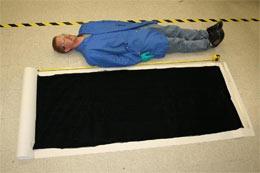
As big as a bed sheet, and the carbon won't rub off.
NANOCOMP TECHNOLOGIES
Posted on 02/29/2008 9:21:00 PM PST by neverdem
Briefing
As big as a bed sheet, and the carbon won't rub off.
NANOCOMP TECHNOLOGIES
A company in the United States has made a sheet from tiny carbon nanotubes. Nature News finds out whether bigger is better when it comes to the very small.
I thought the whole point about carbon nanotubes was that they are 'nano' — really, really small. True. As the name implies, nanotubes are on the order of 10-9 metres in size: they are famed for being thinner than human hair, and are typically less than a millimetre long. But they pack a lot of punch into such a small structure. They are extremely strong and stiff, they conduct heat efficiently, and if made properly are excellent conductors of electricity. To take advantage of these amazing properties, you need to make a larger structure out of the tiny tubes.
So now someone has made a sheet? That's right. Nanocomp Technologies, a company from Concord, New Hampshire, has woven carbon nanotubes into tiny bundles up to 30 nanometres in diameter, each made from a few dozen nanotubes (Nanocomp's tubes are slightly longer than your average nanotube — up to a few millimetres in length). This material is then delivered onto a rotating drum, and layers of it are built up over a matter of hours. Strong electrostatic forces between tubes hold the bundles together. Finally a sheet can be cut off from the drum.
How big is the sheet? The biggest sheets made so far are about 1 metre by 2 metres, containing about a billion billion nanotubes (more than 1017). Previously, nanotubes have been made into ribbons — in 2005, a group reported a sheet that was metres long, but just 5 centimetres wide.
The company says that there is no scientific limit to how big their sheets can get. This is a buyer’s market, “sheet size will be defined more by market requirements and customer demand,” says Nanocomp’s John Dorr.
What are its properties? It is super strong — with breaking strengths ranging from 200 megapascals to more than 1,000 megapascals (around 150,000 PSI). Aluminium alloys can have a breaking strength of 500 megapascals and stainless steel can be 700 megapascals. The different sheet strengths depend on how the material is processed, says Dorr. It can be stretched out physically so that the tubes align in a certain direction, or treated with chemicals, both to improve strength.
They sheets are also lightweight, with a density of 0.2-0.3 grams per cubic centimetre (30 times less dense than steel). The final material is paper-like and can be folded, stretched and cut with scissors.
If it's made from carbon, like pencil lead, does that mean if I wrap myself in a sheet made from nanotubes I’m going to get covered in black dust? In principle, yes. In their natural state the sheets would behave just as you would expect graphite to, and you would have little specks of black on your hands. But the sheets are treated to prevent this happening.
What will I be able to make from these sheets? Can I make a lightweight aeroplane? You might just manage to make a paper aeroplane, since each sheet is a bit like paper. Aerospace could still benefit by using the sheets as part of a composite coating for planes. The lightweight sheets conduct electricity, so could help to shield sensitive bits of electronic equipment from lightning by steering the charge around sensitive parts.
The sheets could also protect small electronic devices from electromagnetic interference.
I thought carbon nanotubes were going to take us into space? Ah, you're thinking of space elevators — yes, in principle a space elevator could zip up to a low-Earth orbit on a tether made out of super-tough, super-light material, and carbon nanotubes are the firm favourites to be the material that such a tether would be made from. In fact, a long, thin rope made from Nanocomp’s material was used in last year’s space elevator games in the strong tether competition by the DeltaX team. But the tether snapped.
Space elevators need a ribbon of carbon nanotubes, not a sheet. But people in that community are still excited by the development, as it shows how far carbon nanotube manufacturing has come.
Body armor of the future.
Reporters don't do math, and exponents are way beyond their scope.
I'll say.
was thinking exactly the same thing....
Nanoo nanoo... - Mork..
1X10^17?
Dumbest. Idea. Ever.
Well, the copying & pasting didn’t retain the superscript in the original...
A big 10-9 here good buddy.
Considering it was conceived by one of the smartest men who ever lived (Sir Arthur C Clarke) I think you should back up the statement.
Before he is dismissed as a science fiction writer remember that he also was the mind behind geosynchronous orbits as well as a number of other major scientific 'discoveries'.
Let me follow-up on my own response. A quote from Sir Clarke himself:
Any sufficiently advanced technology is indistinguishable from magic
A space elvevator, while unconventional, is really a practical solution to a lot of the problems we are having with space travel.
Who's your daddy, Einstein? ;)



Gene Expression Differences Between Europeans And Africans Affect Response To Drugs, Infections
Blind Irishman sees with the aid of son's tooth in his eye
Singing starlings: why...boys are being born "girls" (estrogen pollution gender-bending the planet)
FReepmail me if you want on or off my health and science ping list.
Disclaimer: Opinions posted on Free Republic are those of the individual posters and do not necessarily represent the opinion of Free Republic or its management. All materials posted herein are protected by copyright law and the exemption for fair use of copyrighted works.